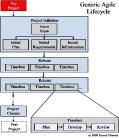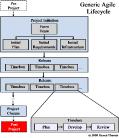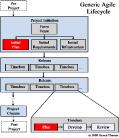
There are some important questions to be addressed before the start of any project like “Why are we doing this project?” and “Should we do this project?” Project Initiation is the phase where these questions are answered but some work has usually been done before.
Find/Write Project Brief

 Projects don’t happen in isolation. The key question during project initiation is “Should we invest more?”, i.e. is the project worth going ahead with? There must be a reason for the project. The first step during Agile Project Initiation is to find this reason. Often with software development there are just too many choices for what the team could do. A Project Brief can help remove this confusion by pointing the general direction in which the team is meant to head.
Projects don’t happen in isolation. The key question during project initiation is “Should we invest more?”, i.e. is the project worth going ahead with? There must be a reason for the project. The first step during Agile Project Initiation is to find this reason. Often with software development there are just too many choices for what the team could do. A Project Brief can help remove this confusion by pointing the general direction in which the team is meant to head.
The format of a Project Brief document might be a Project Vision, in part of a Product Road Map or a Project Mission Statement but the key thing is knowing why we’re spending this money on this activity.
Marty Cagan of the Silicon Valley Product Group suggests we provide good answers to nine questions to know if we are pursing a good opportunity. The nine questions of the Opportunity Assessment are:
- Exactly what problem will this solve? (value proposition)
- For whom do we solve that problem? (target market)
- How will we measure success? (business metrics)
- What alternatives are out there? (competitive landscape)
- Why we are best suited to pursue this? (our differentiator)
- Why now? (market window)
- How will we deploy this? (gentle deployment strategy)
- What is the preliminary estimated cost? (small/medium/large)
- What factors are critical to success? (solution requirements)
I encourage Product Owners to answer these questions before launching the project proper.
High Fidelity Prototype
The Silicon Valley Product Group recommend a a High Fidelity Prototype rather than using documents to describe the target system. If the Project Brief gets the go ahead then invest some time in putting together a click through prototype of the system.
References
Silicon Valley Product Group





 Projects don’t happen in isolation. The key question during project initiation is “Should we invest more?”, i.e. is the project worth going ahead with? There must be a reason for the project. The first step during
Projects don’t happen in isolation. The key question during project initiation is “Should we invest more?”, i.e. is the project worth going ahead with? There must be a reason for the project. The first step during